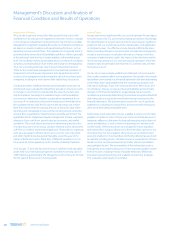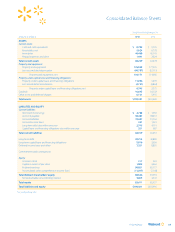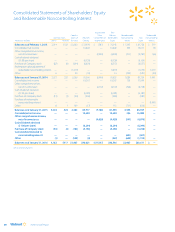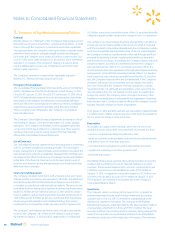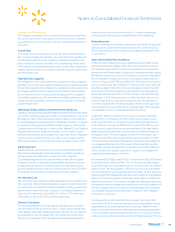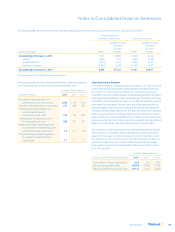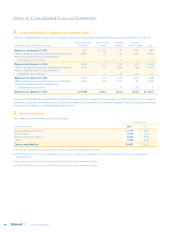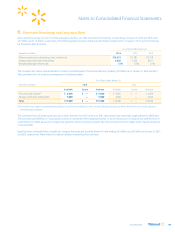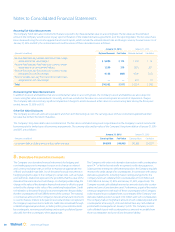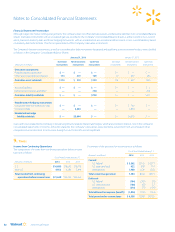Walmart 2016 Annual Report Download - page 44
Download and view the complete annual report
Please find page 44 of the 2016 Walmart annual report below. You can navigate through the pages in the report by either clicking on the pages listed below, or by using the keyword search tool below to find specific information within the annual report.
2016 Annual Report42
The following table reflects goodwill activity, by reportable segment, for
fiscal 2016 and 2015:
Walmart
(Amounts in millions) Walmart U.S. International Sam’s Club Total
Balances as of
February 1, 2014 $451 $18,746 $313 $19,510
Changes in currency
translation and other — (1,418) — (1,418)
Acquisitions
(1)
10 — — 10
Balances as of
January 31, 2015 461 17,328 313 18,102
Changes in currency
translation and other — (1,412) — (1,412)
Acquisitions
(1)
— 5 — 5
Balances as of
January 31, 2016 $461 $15,921 $313 $16,695
(1) Goodwill recorded for fiscal 2016 and 2015 acquisitions relates to acquisitions that
are not significant, individually or in the aggregate, to the Company’s Consolidated
Financial Statements.
Indefinite-lived intangible assets are included in other assets and
deferred charges in the Company’s Consolidated Balance Sheets. These
assets are evaluated for impairment based on their fair values using valu-
ation techniques which are updated annually based on the most recent
variables and assumptions. There were no impairment charges related to
indefinite-lived intangible assets recorded for fiscal 2016, 2015 and 2014.
Self Insurance Reserves
The Company self-insures a number of risks, including, but not limited
to, workers’ compensation, general liability, auto liability, product liability
and certain employee-related healthcare benefits. Standard actuarial
procedures and data analysis are used to estimate the liabilities associated
with these risks as of the balance sheet date on an undiscounted basis.
The recorded liabilities reflect the ultimate cost for claims incurred but
not paid and any estimable administrative run-out expenses related to
the processing of these outstanding claim payments. On a regular basis,
claims reserve valuations are provided by independent third-party
actuaries to ensure liability estimates are appropriate. To limit exposure
to some risks, the Company maintains insurance coverage with varying
limits and retentions, including stop-loss insurance coverage for workers’
compensation, general liability and auto liability.
Income Taxes
Income taxes are accounted for under the balance sheet method. Deferred
tax assets and liabilities are recognized for the estimated future tax
consequences attributable to differences between the financial statement
carrying amounts of existing assets and liabilities and their respective
tax bases (“temporary differences”). Deferred tax assets and liabilities are
measured using enacted tax rates in effect for the year in which those
temporary differences are expected to be recovered or settled. The effect
on deferred tax assets and liabilities of a change in tax rate is recognized
in income in the period that includes the enactment date.
Deferred tax assets are evaluated for future realization and reduced by
a valuation allowance to the extent that a portion is not more likely than
not to be realized. Many factors are considered when assessing whether
it is more likely than not that the deferred tax assets will be realized,
including recent cumulative earnings, expectations of future taxable
income, carryforward periods, and other relevant quantitative and
qualitative factors. The recoverability of the deferred tax assets is evaluated
by assessing the adequacy of future expected taxable income from all
sources, including reversal of taxable temporary differences, forecasted
operating earnings and available tax planning strategies. These sources
of income rely heavily on estimates.
In determining the provision for income taxes, an annual effective income
tax rate is used based on annual income, permanent differences between
book and tax income, and statutory income tax rates. Discrete events
such as audit settlements or changes in tax laws are recognized in the
period in which they occur.
The Company records a liability for unrecognized tax benefits resulting
from uncertain tax positions taken or expected to be taken in a tax return.
The Company records interest and penalties related to unrecognized tax
benefits in interest expense and operating, selling, general and adminis-
trative expenses, respectively, in the Company’s Consolidated Statements
of Income. Refer to Note 9 for additional income tax disclosures.
Revenue Recognition
Sales
The Company recognizes sales revenue, net of sales taxes and estimated sales
returns, at the time it sells merchandise to the customer. Digital retail sales
include shipping revenue and are recorded upon delivery to the customer.
Membership Fee Revenue
The Company recognizes membership fee revenue both in the U.S.
and internationally over the term of the membership, which is typically
12 months. The following table summarizes membership fee activity
for fiscal 2016, 2015 and 2014:
Fiscal Years Ended January 31,
(Amounts in millions) 2016 2015 2014
Deferred membership fee revenue,
beginning of year $ 759 $ 641 $ 575
Cash received from members 1,333 1,410 1,249
Membership fee revenue recognized (1,348) (1,292) (1,183)
Deferred membership fee revenue,
end of year $ 744 $ 759 $ 641
Membership fee revenue is included in membership and other income
in the Company’s Consolidated Statements of Income. The deferred
membership fee is included in accrued liabilities in the Company’s
Consolidated Balance Sheets.
Shopping Cards
Customer purchases of shopping cards are not recognized as revenue
until the card is redeemed and the customer purchases merchandise
using the shopping card. Shopping cards in the U.S. do not carry an
expiration date; therefore, customers and members can redeem their
shopping cards for merchandise indefinitely. Shopping cards in certain
foreign countries where the Company does business may have expiration
dates. A certain number of shopping cards, both with and without
expiration dates, will not be fully redeemed. Management estimates
unredeemed shopping cards and recognizes revenue for these
amounts over shopping card historical usage periods based on historical
redemption rates. Management periodically reviews and updates its
estimates of usage periods and redemption rates.
Notes to Consolidated Financial Statements


